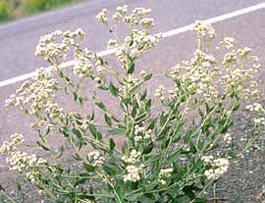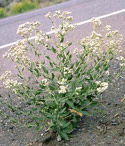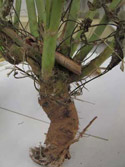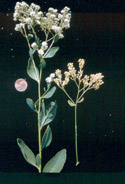Perennial Pepperweed
Lepidium latifolium • Class B |
||
| Family Name: | Brassicaceae family (brass-ih-KAY-see-ee) | |
| Common: | Cabbage family (formerly Cruciferae) | |
| Genus: |
Lepidium (lep-PID-ee-um) Meaning: From the Greek lepis (scale) referring to the shape of the seed pods |
|
| Species: |
latifolium (lat-ih-FOH-lee-um) Meaning: Wide leaves |
|
| Description: |
Perennial pepperweed normally grows 1 to 3 feet tall, but may reach heights of up to 6 feet tall. It has many stems emerging from a woody root crown. Its alternate, waxy leaves are dark bluish green to grayish green in color with a whitish mid-vein. The lance shaped basal leaves are up to 12 inches long with long stalks. Stem leaves are smaller with short stalks. Rounded clusters of small white flowers adorn the tops of its stems from June to September. |
| Why Is it a Noxious Weed? |
The competitive nature of Perennial pepperweed poses a serious threat to many native undisturbed areas. Dense infestations of Perennial pepperweed can form near monocultures. Accumulations of its semi-woody stems degrade nesting habitat for wildlife, interfere with the regeneration of willows and cottonwood trees. Dense infestations degrade waterfowl nesting habitats. |
| Where Does it Grow? |
It is an aggressive non-native plant of the mustard family, which tends to establish and rapidly colonize pastures, riparian habitats, waste places, wet areas, ditches, and along roadsides. It can also be a problem in roadside, rangeland, and field cropland, and even dry habitats. In coastal areas, the plant invades brackish marshes. |
| Facts: |
Perennial pepperweed infestations can produce over 6.4 billion seeds per acre annually. |
| Control Options: |
|
| More Information: |
Download our Flyer or visit Washington State Noxious Weed Control Board Here. Photo by Leo Michels
|
| More Pictures: |




